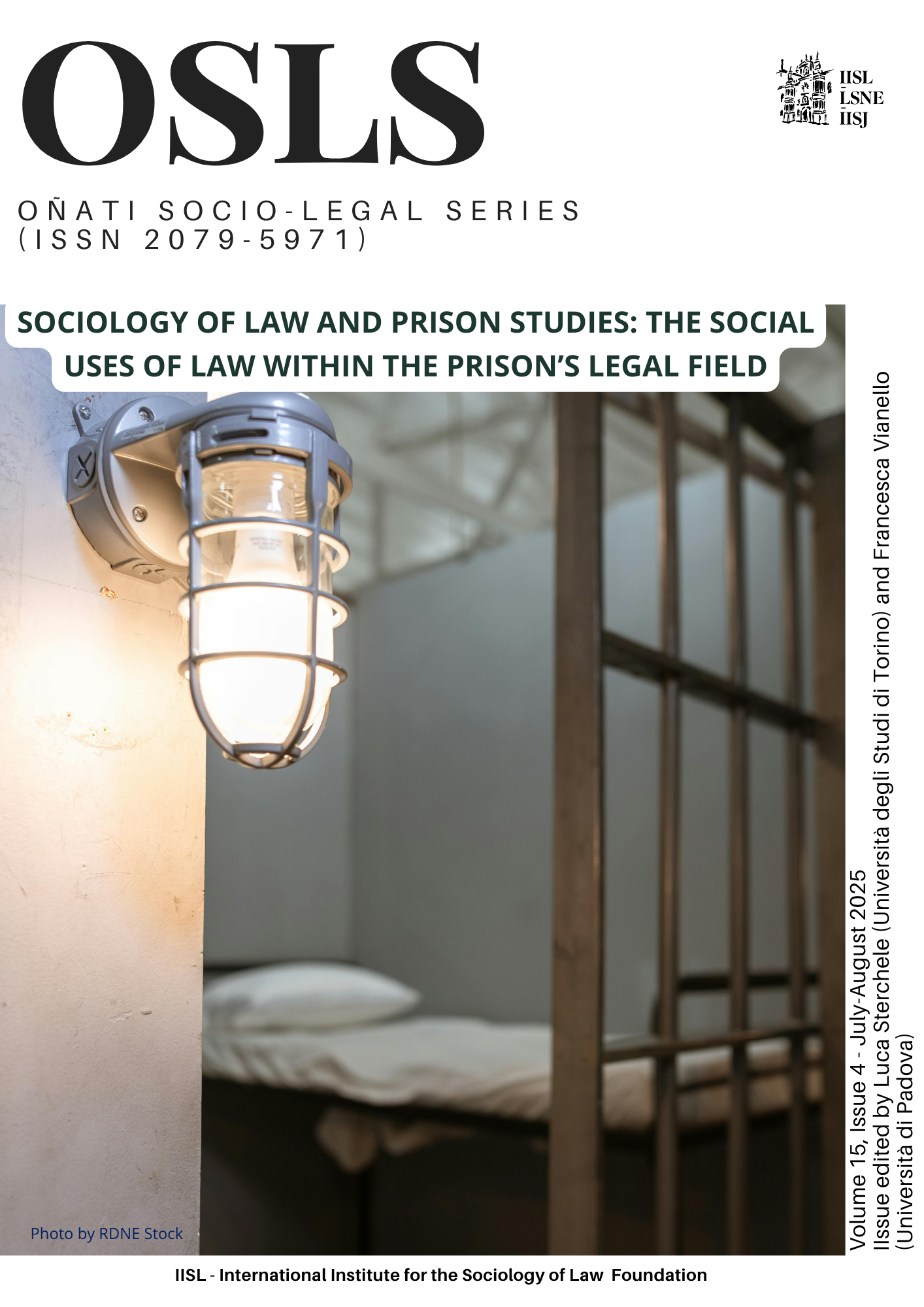Prison educators in the shadow of prison rules
Results from a field research in Italy
DOI:
https://doi.org/10.35295/osls.iisl.2052Keywords:
Prison staff, Legal Culture, Prison studiesAbstract
The essay presents the findings of a research study that investigated the legal and professional culture of prison officers responsible for supporting and rehabilitating inmates. The professional roles of educators, social workers, and experts in psychology and criminology were introduced into the Italian prison system following the reform of 1975 and subsequent amendments. Nearly 50 years after the reform came into effect, numerous questions remain open regarding the impact within the Italian prison system. Specifically, the research sought to determine to what extent these experts have influenced the professional culture and the culture of punishment among prison actors in Italy. Furthermore, more generally, the study questioned the impact of these roles on Italian prison practices. The results stem from three distinct periods of direct and participant observation during which the researcher served as a prison educator at a Northern Italian prison. The qualitative data collected suggest that treatment officers have only partially influenced the professional culture of other prison actors. Moreover, there appeared to be limited ability to alter the daily practices of the prison. Instead, these officers seem to have been profoundly influenced by the prison environment, which has facilitated the development of at least three critical issues addressed in the text: bureaucratization, defensive behaviour, and adherence to a punitive culture.
Downloads
Metrics
Global Statistics ℹ️
|
791
Views
|
508
Downloads
|
|
1299
Total
|
|
References
Baratta, A., 2019. Criminologia critica e critica del diritto penale. Introduzione alla Sociologia giuridico penale. Milan: Meltemi.
Bennet, J., Crewe, B., and Wahidin, A., eds., 2007. Understanding Prison Staff. London: Willan.
Buccoliero, C., and Uccello, S., 2022. Senza sbarre. Storia di un carcere aperto. Turin: Einaudi.
Cellini, G., 2013. Controllo sociale, servizio sociale e professioni di aiuto. Una ricerca nel sistema penitenziario. Milan: Ledizioni.
Clemmer, D., 1958. Prison Community. Chicago: Rinehart & Company.
Crewe, B., 2009. The Prisoner Society: Power, Adaptation and Social Life in an English Prison [online]. Oxford University Press. Available at: https://doi.org/10.1093/acprof:oso/9780199577965.001.0001 DOI: https://doi.org/10.1093/acprof:oso/9780199577965.001.0001
De Leonardis, O., 2001. Le istituzioni. Come e perché parlarne. Rome: Carocci.
De Vito, C., 2009. Camosci e girachiavi. Storia del carcere in Italia. Bari/Rome: Laterza.
Feeley, M., and Simon, J., 1994. Actuarial justice: The emerging new criminal law. In: D. Nelken, ed., The futures of criminology. London: Sage, 173-201.
Ferrajoli, L., 2016. Il paradigma garantista. Filosofia e critica del diritto penale. Naples: Editoriale Scientifica.
Foucault, M., 1975. Surveiller et punir. Naissance de la prison. Paris: Gallimard.
Garland, D., 2002. The Culture of Control: Crime and Social Order in Contemporary Society [online]. Oxford University Press. Available at: https://doi.org/10.1093/acprof:oso/9780199258024.001.0001 DOI: https://doi.org/10.1093/acprof:oso/9780199258024.001.0001
Goffman, E., 1961. Asylums: Essays on the Social Situation of Mental Patients and Other Inmates. New York: Anchor Books.
Jones, R., et al., 2009. The First Dime: A Decade of Convict Criminology. The Prison Journal [online], 89(2), 151-157. Available at: https://doi.org/10.1177/0032885509334744 DOI: https://doi.org/10.1177/0032885509334744
Liebling, A., Price, D., and Shefer, G., 2010. The Prison Officer [online]. London: Willan. Available at: https://doi.org/10.4324/9780203832998 DOI: https://doi.org/10.4324/9780203832998
Lippi, A., and Morisi, M., 2005. Scienza dell’amministrazione. Bologna: Il Mulino.
Manconi, L., and Torrente, G., 2015. La pena e i diritti. Il carcere nella crisi italiana. Rome: Carocci.
Martinson, R., 1974. What works? Questions and answers about prison reform. The Public Interest [online], 35, 22–53. Available at: https://www.nationalaffairs.com/public_interest/detail/what-works-questions-and-answers-about-prison-reform
Melossi, D., 2015. Crime, Punishment and Migration [online]. London: Sage. Available at: https://doi.org/10.4135/9781473920965 DOI: https://doi.org/10.4135/9781473920965
Nelken, D., 2005. When a society is non-punitive? The Italian case. In: J. Pratt et al., eds., The new punitiveness. Trends, theories, perspective. London: Willan, 218-235.
Pratt, J., 2007. Penal Populism [online]. London: Routledge. Available at: https://doi.org/10.4324/9780203963678 DOI: https://doi.org/10.4324/9780203963678
Ross, J.I., and Richard, S.C., 2003. Convict Criminology. Belmont: Wadsworth.
Sarzotti, C., 1999. Codice paterno e codice materno nella cultura giuridica degli operatori penitenziari. In: A.R. Favretto and C. Sarzotti, eds., Le carceri dell’AIDS. Indagine su tre realtà italiane. Turin: L’Harmattan Italia, 9-84.
Sarzotti, C., 2010. Il campo giuridico del penitenziario: appunti per una ricostruzione. In: F. Belvisi et al., eds., Diritto come questione sociale. Turin: Giappichelli, 181-238.
Sudnow, D., 1965. Normal Crimes: Sociological Features of the Penal Code in a Public Defender Office. Social Problems [online], 12(3), 255-276. Available at: https://psycnet.apa.org/doi/10.1525/sp.1965.12.3.03a00010 DOI: https://doi.org/10.1525/sp.1965.12.3.03a00010
Sutherland, E.H., and Cressey, D.R., 1978. Criminology. Philadelphia: Lippincott.
Sykes, G.M., 1958. Society of Captives: A Study of a Maximum Security Prison [online]. Princeton University Press. Available at: https://psycnet.apa.org/record/2007-05794-000 DOI: https://doi.org/10.1515/9781400828272
Zimbardo, P., 2008. The Lucifer Effect: How Good People Turn Evil. London: Rider.
Published
How to Cite
Issue
Section
License
Copyright (c) 2025 Giovanni Torrente

This work is licensed under a Creative Commons Attribution-NonCommercial-NoDerivatives 4.0 International License.
OSLS strictly respects intellectual property rights and it is our policy that the author retains copyright, and articles are made available under a Creative Commons licence. The Creative Commons Non-Commercial Attribution No-Derivatives licence is our default licence and it regulates how others can use your work. Further details available at https://creativecommons.org/licenses/by-nc-nd/4.0 If this is not acceptable to you, please contact us.
The non-exclusive permission you grant to us includes the rights to disseminate the bibliographic details of the article, including the abstract supplied by you, and to authorise others, including bibliographic databases, indexing and contents alerting services, to copy and communicate these details.
For information on how to share and store your own article at each stage of production from submission to final publication, please read our Self-Archiving and Sharing policy.
The Copyright Notice showing the author and co-authors, and the Creative Commons license will be displayed on the article, and you must agree to this as part of the submission process. Please ensure that all co-authors are properly attributed and that they understand and accept these terms.























